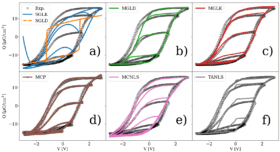11. May 2022
IEEE TED 2022: Models for Thin Films vs. Experiment Data
In his recent IEEE TED article “On the Modeling of Polycrystalline Ferroelectric Thin Films: Landau-Based Models Versus Monte Carlo-Based Models Versus Experiment“, GTS scientist Mischa Thesberg compared seven different models to actual experimental data.

Heavily polycrystalline ferroelectric nanofilms, such as those of doped hafnium oxide (HZO / HfZrO2), have great potential for technological application. However, the heavily polycrystalline nature of these materials invalidates conventional modeling approaches as the dynamics have been found to: 1) be nucleation-limited, and 2) involve grains of ferroelectric material interspersed among grains of alternative, nonferroelectric material; finally 3) the direct interaction between these grains is observed to be minimal. Seven separate compact or ”0-D” models of such polycrystalline films were considered – four based on a Landau paradigm, two on a Monte Carlo (MC) paradigm, and the traditional Preisach model. All of these models have been used in the literature to model novel polycrystalline ferroelectric nanofilms. With his team, Mischa compared and contrasted the accuracy and physical appropriateness of each model by comparing both their static and dynamic properties against experimental data. It turned out that not all models were equally valid.
OpenAccess Paper
We have chosen to make the paper available through Open Access because we feel it’s important to support the free exchange of ideas. The paper is available through IEEE Xplore (DOI: 10.1109/TED.2022.3167942) – or you can download the paper at MyGTS.
Read more about dealing with new materials and explore our application examples. Feel free to contact us directly for specific enquiries.
All covered in GTS Framework
As a comprehensive suite, GTS Framework includes all seven models, empowering users to compare and select what fits best for their application – be it SGLK / SGLD, MGLD, MGLK, MCP, MCNLS, or TANLS.
IEEE IRPS 2022: Hafnia-based Ferroelectric Gatestacks
Closely related, Mischa contributed to B. Truijen’s IRPS paper “Trap-polarization interaction during low-field trap characterization on hafnia-based ferroelectric gatestacks” in collaboration with imec. Mischa helped developing the ferro-electric models that were used in this work.
The paper is available at IEEE Explore.
